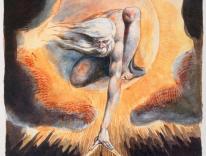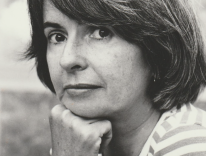Called Out of Darkness
A Spiritual Confession
Anne Rice
Alfred A. Knopf, $24, 256 pp.
Some years ago I considered writing a long book of conversion stories—starting with John Henry Newman and ending with some contemporary converts. The project never got off the ground, but I never lost my taste for reading about conversion experiences. For that reason alone, the story Anne Rice tells in Called Out of Darkness had an almost instant appeal to me. The broad outline of the story will already be familiar to many readers: Rice, a writer famous for gothic novels involving dark angels and vampires, returned to her childhood faith more than a decade ago and began writing a series of books that retell the life of Jesus, two of which have already been published.
Rice's account of her childhood offers a brilliant portrait of pre-Vatican II Catholicism set against the lush background of New Orleans. She was born into a Catholic family that went back several generations. She tells us about her early childhood, her Catholic education, and her bittersweet relationship with her mother, who drank herself to death when Rice was just fourteen.
Rice went off to college, married, and moved to the Bay Area with her husband. There the old doubts grew into a new conviction to match her new identity: suddenly she is “an adult, an atheist, I live in Berkeley, California. I'm married and I have a beautiful child.” The story of how she eventually made her way back to the church involves tragedy (the death of a child from leukemia), a move back to New Orleans, and a rediscovery of the places where her devout childhood had been nurtured. Her imaginative and emotional life had been so profoundly shaped by her Catholic upbringing that at least to this reader it appears she never quite lost her faith, though it smoldered almost undetected for a long time. During that time she had lived without the nourishment of devotion, without Catholic places (she is particularly good at describing the architecture of churches and chapels), and without the sacraments that had fed her fundamentally mystical mind.
But it wasn't nostalgia that led her back to the church; it was a profound love for Jesus himself. Hence her decision to retell his story. There were ancillary reasons for her return to her childhood faith—and she goes over them in detail—but it was really a new insight into the deepest meaning of the Incarnation that provided her with both the impulse to believe and the nourishment to sustain her faith. She found that the story of Christ explains the world and her own self: “This is a mystical thing that I am trying to analyze; it is a transcendent moment when one senses with all one's faculties that the love of God is the air we breathe.” It was on this basis—a simple faith in the person of Jesus Christ—that Rice returned to the faith she had abandoned so many years before. There is an important pastoral lesson in that for those who wish to make the Catholic faith credible in this age.
Renewing Parish Culture
Building for a Catholic Future
John J. Piderit, SJ, and Melanie M. Morey
Rowman & Littlefield, $29.95, 256 pp.
John J. Piderit, SJ, and Melanie M. Morey are the authors of the much-discussed Catholic Higher Education: A Culture in Crisis (Oxford University Press, 2006), which triggered many debates on the “Catholic character” of Catholic colleges and universities. The same authors have now teamed up again to write about the state of Catholic parishes in the United States.
In their preface, they write that while parishes are at the heart of the American church, the story of the American parish is today a “complicated narrative”—and not an entirely reassuring one. Most Catholics would probably say “amen” to that. Every day comes news of parishes being closed or consolidated, of priest shortages, of fewer Catholics attending Mass regularly, of Catholics for whom parish life is a mere memory.
But, as its title suggests, Renewing Parish Culture is less concerned with rehearsing the problems of parish life today than with focusing on ways to reinvigorate parishes. The authors' ideas are modeled on the success of the religious sisters who were so vital to parish life and other ministries a few generations ago. Piderit and Morey are not trying to duplicate a previous era in the church, but they do want to discover why religious sisters were so effective. Their conclusion: religious women in a variety of ministries “gave Christian witness, executed well, made deft dynamic adjustments, recruited effectively, exercised financial realism, and promoted growth and competition.”
The challenge is to transfer these virtues and methods to the parish. The authors divide the rest of the book into two large sections: one devoted only to parishes, the other to both the parish and the diocese. In the first section the authors write about how to develop a robust liturgical life, about the structure of religious education for both children and adults, and about ways to enhance service (diakonia—hence our word “deacon”). In the second section they highlight such familiar and vexatious topics as priest shortages and the development of lay leaders, as well as the ever-looming problem of church finances.
It is hard for me to judge whether their recommendations are practical, or even possible, since my own perspective is from the pew, but it does seem to me that this book would be an excellent point of departure for discussions at both the parochial and the diocesan levels. Informed by a sophisticated social theory and theology, Renewing Parish Culture arrives at some very concrete proposals. It is designed not only to be read and discussed but also to be used.
The Bible Is for Living
A Scholar's Spiritual Journey
Philip J. King
Biblical Archaeological Society, $24.95, 199 pp.
Fr. Philip J. King, recently retired from teaching Scripture at Boston College, is justly proud of the fact that he is the only American scholar who has ever presided over the Society for Biblical Literature, the American Schools of Oriental Research, and the Catholic Biblical Association. This distinguished CV reflects the esteem of King's academic peers, which he earned with a prodigious amount of scholarly research. His work has ranged from field archaeology reports to biblical commentaries. In The Bible Is for Living, King has written a small book in which he looks at sacred Scripture through the lens of his own life as priest and believer.
The book's nine chapters address such key biblical tropes as covenant, holiness, prayer, prophetism, wisdom, and biblical women. The reflections on “faith, hope, and charity” are representative of the book's overall excellence. We are all familiar with the passage about love in First Corinthians—“And now faith, hope, and love abide, these three; and the greatest of these is love” (13:13). King points out that Paul uses this triad in at least four other places (for example, I Thessalonians 1:3). Considering all these passages together allows King to meditate on the three virtues at some length, tracing them from Paul's epistles to their antecedents in the Old Testament, then drawing them forward into contemporary life.
The last chapter of the book, devoted to “key aspects of the spiritual life,” offers a series of profound meditations on several verses from the Bible, beginning, aptly enough, with this affecting statement in the Book of Isaiah: “The Word of Our God will stand forever” (40:8). Here, as in the rest of the book, the author makes the familiar unfamiliar; like the Good Householder in the Gospel, he is able to draw forth old things and new. The Bible Is for Living is a fitting coda to the career of this accomplished priest and scholar.
I'd Rather Teach Peace
Colman McCarthy
Orbis Books, $16, 160 pp.
Colman McCarthy's I'd Rather Teach Peace, which made its first appearance six years ago, is now available in an affordable paperback edition from Orbis Press. McCarthy, a longtime columnist for the Washington Post, is both a contrarian and a peacemaker. For decades he taught courses on peace and reconciliation to students drawn from Georgetown Law, inner-city public schools, fancy private academies, and juvenile prisons. Frequently, he taught those courses for no pay to students who were--at least to begin with—less than eager.
I'd Rather Teach Peace is a record of those experiences, as well as a vade mecum for teachers inclined to try unconventional methods. A good example of McCarthy's approach: He asks a class of law-school students to tell him where they got their education. They answer with a list of colleges, so he asks them where they got their elementary education and, after they tell him, challenges them to write thank-you letters to the grade-school teachers they remember best. In McCarthy's estimation, those teachers are the real heroes in education today. Another example: He gives a quiz with the promise that anyone who can identify all of five names will get a crisp hundred-dollar bill. Because the last two names on his list belong to important peacemakers, well known only among people who do similar work, none of his students ever wins. McCarthy's point: Our culture tends to forget the voice for peace, while we remember the makers of war and the captains of industry.
Some books one reads and keeps for future consideration. Others one wants to send along to somebody else right away. I am going to send my copy of I'd Rather Teach Peace to the people who direct Notre Dame's Alliance for Catholic Education (ACE)—and suggest that they give a copy to every new teacher going off from ACE to serve in Catholic schools for two years. It doesn't matter whether they are teaching courses on peace and nonviolent reconciliation. In McCarthy's book they will discover how a student's life can be changed by a great teacher, and how a great teacher thinks.
A Community Called Taizé
A Story of Prayer, Worship and Reconciliation
Jason Brian Santos
InterVarsity Press, $15, 204 pp.
A few years ago, Jason Santos, a former youth minister who is now studying at Princeton Theological Seminary, decided to visit Taizé, the famous ecumenical community in France. At the first prayer service he attended, the community's founder, Brother Roger, was stabbed to death by a deranged woman. The horrible event did not deter Santos from further visits, however; and now, with the encouragement of the community, Santos has written a very informative book about Taizé, which he hopes will encourage other young people to visit the community so that they can benefit from its spiritual wisdom.
A Community Called Taizé, published by InterVarsity Press as part of a series on spirituality, is partly a guide book. Santos describes the daily life of the community in great detail. He tells us what visitors should bring for a week's visit and how exactly to get there. (Taizé is in southern Burgundy, close to Cluny.) Since the Taizé monks encourage young people to come and stay with them—they have about a hundred thousand visitors each year—there's a great need for the sort of practical information this book offers. But older readers who have no intention of traveling to Taizé may also appreciate Santos's short history of how the community got started, expanded, and eventually became a model for other ecumenical communities. The author also discusses the community's evolving relationship with the Catholic Church. (Brother Roger's successor, Brother Alois, is a Catholic from Germany.)
Taizé is justly credited with having reintroduced the monastic charism to twentieth-century Protestantism, but it is also authentically ecumenical, including Roman Catholics and Orthodox Christians as well as Protestants. The community is well known for its “Taizé Prayer,” which has spread throughout the world, and for its special appeal to the young who come from all over the world to deepen their Christian faith and hear the Taizé message of reconciliation in Christ. Among the many good things in this book is an excellent discussion of the development of the Taizé style of prayer and chant, with its roots in the pioneering work of the French Jesuit Joseph Gelineau.
While this book is no substitute for the writings of Taizé's members—especially those of Brother Roger and the now-deceased theologian Max Thurian—it is a worthy introduction to one of the most interesting and edifying movements in the Christian world today.
Beyond Tolerance
Searching for Interfaith Understanding in America
Gustav Niebuhr
Viking, $15, 256 pp.
Since 9/11 there has been a small but steady undercurrent of religious intolerance that has erupted now and again in violence. In the past presidential campaign, some yahoos traded on that intolerance to revile the candidate who would eventually win: Who would vote for a candidate whose middle name was Hussein? The prejudice against Muslims is a conspicuous part of a wider problem that developed as the United States became more demographically diverse. Hindus, Sikhs, and Buddhists now live in areas that were once exclusively Protestant, Catholic, or Jewish. This discontinuity can occasionally erupt in resentment. In some other parts of the world, though, such eruptions are both more visible and more frequent—as well as more dangerous. We in this country have a long way to go, but we have come a long way, too.
Gustav Niebuhr's Beyond Tolerance examines the ongoing emergence of religious tolerance in the United States. Niebuhr tells the stories of people who, singly or collectively, have attempted to cross traditional lines in order to increase interfaith understanding and to foster a greater capacity for tolerance. At their best, says Niebuhr, such efforts are designed not to flatten out religious differences but to show how it is possible to remain faithful to one's convictions without threatening those who do not share them. The Second Vatican Council covered much of the same territory in Nostra aetate, which simultaneously affirmed the church's commitment to the gospel and declared that Catholics do not reject whatever is true in other Christian communities and other religions.
Niebuhr draws on his own extensive travels as a former religion writer for the New York Times to report on people, events, and organizations that reach across religious communities in order to foster respectful exchanges. Some of these are small and local, while others have taken on a national importance. An exchange between Catholics and Jews in Maryland led to the now much-discussed Jewish document Dabru Emet. Niebuhr's chapter on such Jewish-Christian exchanges is alone worth the price of the book.
Beyond Tolerance is journalistic and sociological rather than theological. The author surveys exemplary projects undertaken by people who recognize the critical importance of interfaith dialogue in an age of deep religious conflict. The New Atheists cite such conflict as proof that religion, all religion, is a threat to civilization, but they tend to overlook the sort of people Niebuhr brings to our attention.


